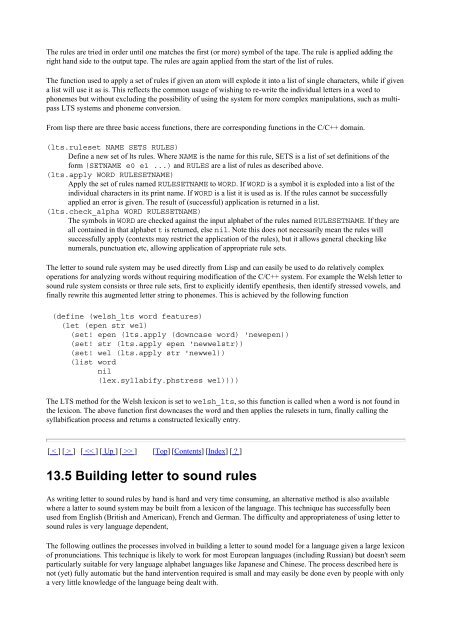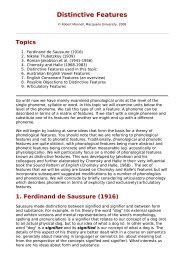Festival Speech Synthesis System: - Speech Resource Pages
Festival Speech Synthesis System: - Speech Resource Pages
Festival Speech Synthesis System: - Speech Resource Pages
Create successful ePaper yourself
Turn your PDF publications into a flip-book with our unique Google optimized e-Paper software.
The rules are tried in order until one matches the first (or more) symbol of the tape. The rule is applied adding the<br />
right hand side to the output tape. The rules are again applied from the start of the list of rules.<br />
The function used to apply a set of rules if given an atom will explode it into a list of single characters, while if given<br />
a list will use it as is. This reflects the common usage of wishing to re-write the individual letters in a word to<br />
phonemes but without excluding the possibility of using the system for more complex manipulations, such as multipass<br />
LTS systems and phoneme conversion.<br />
From lisp there are three basic access functions, there are corresponding functions in the C/C++ domain.<br />
(lts.ruleset NAME SETS RULES)<br />
Define a new set of lts rules. Where NAME is the name for this rule, SETS is a list of set definitions of the<br />
form (SETNAME e0 e1 ...) and RULES are a list of rules as described above.<br />
(lts.apply WORD RULESETNAME)<br />
Apply the set of rules named RULESETNAME to WORD. If WORD is a symbol it is exploded into a list of the<br />
individual characters in its print name. If WORD is a list it is used as is. If the rules cannot be successfully<br />
applied an error is given. The result of (successful) application is returned in a list.<br />
(lts.check_alpha WORD RULESETNAME)<br />
The symbols in WORD are checked against the input alphabet of the rules named RULESETNAME. If they are<br />
all contained in that alphabet t is returned, else nil. Note this does not necessarily mean the rules will<br />
successfully apply (contexts may restrict the application of the rules), but it allows general checking like<br />
numerals, punctuation etc, allowing application of appropriate rule sets.<br />
The letter to sound rule system may be used directly from Lisp and can easily be used to do relatively complex<br />
operations for analyzing words without requiring modification of the C/C++ system. For example the Welsh letter to<br />
sound rule system consists or three rule sets, first to explicitly identify epenthesis, then identify stressed vowels, and<br />
finally rewrite this augmented letter string to phonemes. This is achieved by the following function<br />
(define (welsh_lts word features)<br />
(let (epen str wel)<br />
(set! epen (lts.apply (downcase word) 'newepen))<br />
(set! str (lts.apply epen 'newwelstr))<br />
(set! wel (lts.apply str 'newwel))<br />
(list word<br />
nil<br />
(lex.syllabify.phstress wel))))<br />
The LTS method for the Welsh lexicon is set to welsh_lts, so this function is called when a word is not found in<br />
the lexicon. The above function first downcases the word and then applies the rulesets in turn, finally calling the<br />
syllabification process and returns a constructed lexically entry.<br />
[ < ] [ > ] [ > ] [Top] [Contents] [Index] [ ? ]<br />
13.5 Building letter to sound rules<br />
As writing letter to sound rules by hand is hard and very time consuming, an alternative method is also available<br />
where a latter to sound system may be built from a lexicon of the language. This technique has successfully been<br />
used from English (British and American), French and German. The difficulty and appropriateness of using letter to<br />
sound rules is very language dependent,<br />
The following outlines the processes involved in building a letter to sound model for a language given a large lexicon<br />
of pronunciations. This technique is likely to work for most European languages (including Russian) but doesn't seem<br />
particularly suitable for very language alphabet languages like Japanese and Chinese. The process described here is<br />
not (yet) fully automatic but the hand intervention required is small and may easily be done even by people with only<br />
a very little knowledge of the language being dealt with.
















